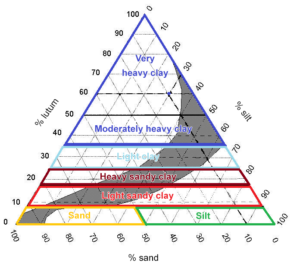Soil
Home > Soil > Considerations > Classification of soil types
Classification of soil types
Sandy and clay soils are classified according to their clay, silt and sand fraction content. The texture triangle shows the proportions naturally occurring in Dutch soils (grey strip).

Lutum or clay fraction: <2 μm
Silt fraction: 2 – 50 μm
Sand fraction: 50 – 2000 μm
The classification of soil types is mainly based on the soil’s lutum (or clay) content.
A sandy soil contains 0 to 8% lutum. Sandy clay soils are lighter clay soils containing 8-12% lutum, classified as light sandy clay soils, 12-17.5% lutum as moderately light sandy clay soils and 17.5-25% lutum as heavy sandy clay soils. Clay soils contain over 25% lutum. Light clay soils contain 25-35% lutum and moderate and heavy clay soils contain over 35% lutum.
Sandy soils can be further classified according to their loam content. Loam, unlike clay, has been deposited by the wind (0-50 μm). Low-loam sand contains 0-10% loam, loamy sandy soil 10-50% loam and loamy soil over 50% loam.
Sources figure:
Jongmans, A.G., M.W. van den Berg, M.P.W. Sonneveld, G. Peek en R. van den Berg van Saparoea (2012). De landschappen van Nederland; geologie, bodem, landgebruik. Wageningen Academic Publishers.
Sources:
Kuipers, S.F. (1984). Bodemkunde. 15e druk. Educaboek, Culemborg. ISBN 901100388 8. 305 p.
Locher, W.P. en H. de Bakker (1990). Bodemkunde van Nederland. Deel 1: algemene bodemkunde. Malmberg Den Bosch. 439 p.


